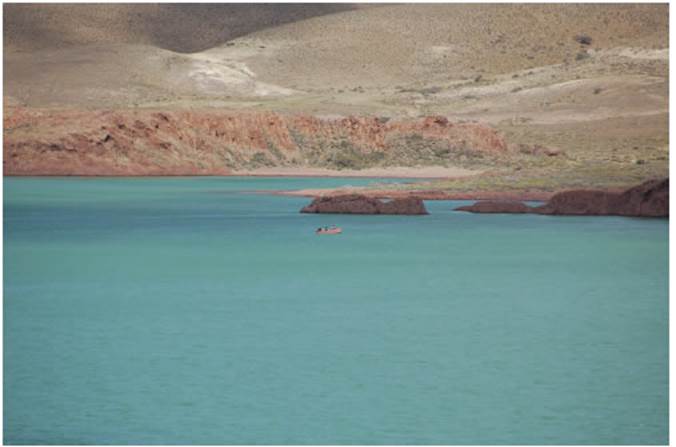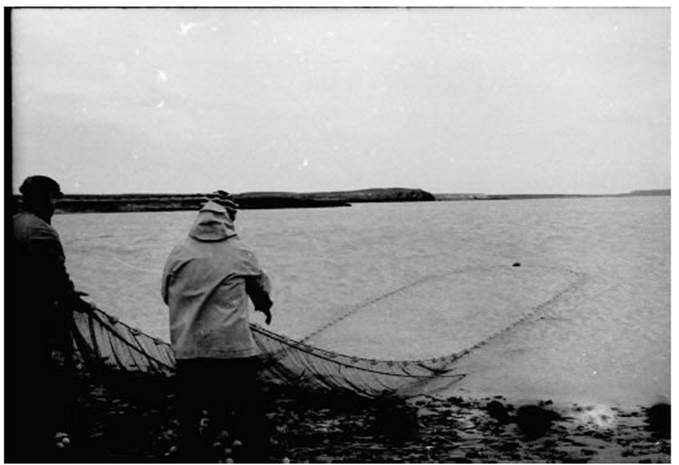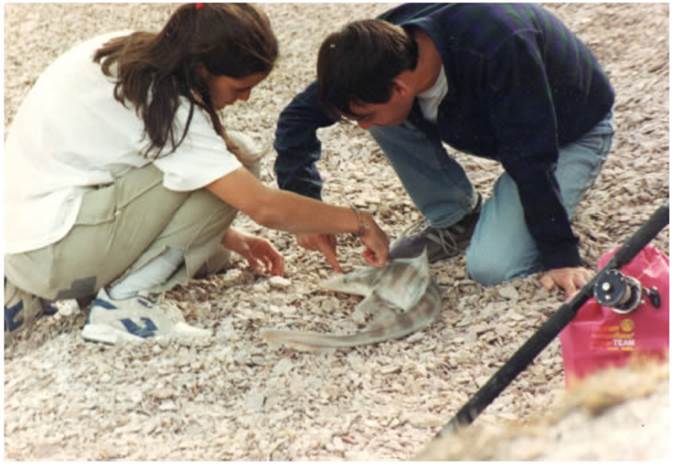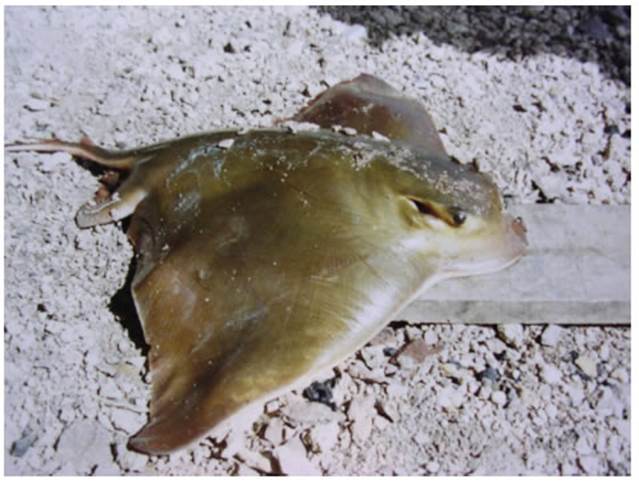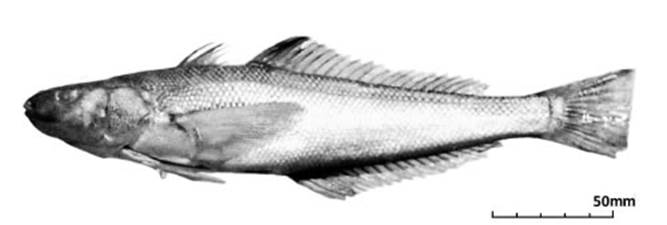INTRODUCTION
The knowledge of the fish diversity of the Argentine Sea is quite unbalanced. Even though the great sampling effort carried out covering the Argentine continental shelf provided a great amount of knowledge (Gneri et al., 1967; Cotrina et al., 1976; Cousseau, 1978; Bellisio et al., 1979; Menni & Gosztonyi, 1982; Menni & López, 1984; among many others), the ichthyological infor mation on coastal waters is relatively limited (Aasen, 1967; Gosztonyi, 1972, 1977; Lloris & Rucabado, 1991; Ciccarone et al., 1993; Caille et al., 1995; among others).
During the 1960s a field laboratory was estab lished by the CIBIMA (Centro de Investigación de Biología Marina = Marine Biology Research Center) at Puerto Deseado, Santa Cruz, (47° 45’ S, 65° 55’ W) in the northern coast of the Ría Deseado (Deseado River Estuary). In this laboratory, Gosztonyi published a series of arti cles on specimens collected within the Ría and near its mouth (Gosztonyi, 1972, 1974a, 1974b, 1977, 1979a, 1979b, 1984, 1988; Gosztonyi & López-Arbarello, 2000; Gosztonyi & McDowall, 1974; Menni et al., 1979) documenting the pres ence and biological aspects of several species of inshore fish fauna. Subsequently, Pettovello continued the biological research in the same locality, expanding the list of the observed spe cies (unpublished), working periodically in the field with Chiaramonte and Tamini, who worked at the same time at the Museo Argentino de Ciencias Naturales (MACN) collection, rescuing and curating the historical material of the study area deposited in there. However, the ichthyo fauna of this estuary currently remains incom pletely described in the literature, a gap that this work aims to bridge.
Based on the above-mentioned research ef forts performed at the Ría Deseado, we present an annotated systematic checklist of the species including five newly reported species for the re gion, as well as a brief analysis of the fluctua tions observed throughout the years in the spe cific composition of this ichthyofauna.
Study área
The Ría Deseado (47°45’ S, 65°55’ W; Fig. 1A) is a 40 km long estuarine penetration of the South Atlantic Ocean into the Patagonian coast (Fig. 1B). The Río Deseado (Deseado River, Fig. 2) discharges into the Ría, with a very low drain age restricted to spring and summer. The salin ity in the Ría Deseado fluctuates between 3.3 and 3.4 %, and the mean surface temperature ranges from 4 to 14 °C. This area is characterized by a very large tidal flux with amplitudes of ap proximately 6 m, with very strong tidal currents, reaching about 6 knots. During low tide, large areas of the rocky and/or muddy tidal zone are exposed, the former including many tide pools. It includes a large number of geographical acci dents, among which are Bahía Uruguay (Fig. 3), Península Stokes and Península Viedma, Isla del Rey (or Isla Conejos), Cañadón del Puerto, Roca Beagle and Restinga Chaffers (Fig. 1C), Cañadón del Indio, Cañadón Torcido and Cañadón del Paraguayo, Península Las Barrancas, Isla de Los Pajaros, Isla Burlotti, Isla Quiroga, Isla Larga, and Isla Quinta, (Fig. 1D), Punta Cascajo, Rocas Dos Hermanas, Punta Cavendish, Península Foca and Roca Foca (Fig. 1E), among others.
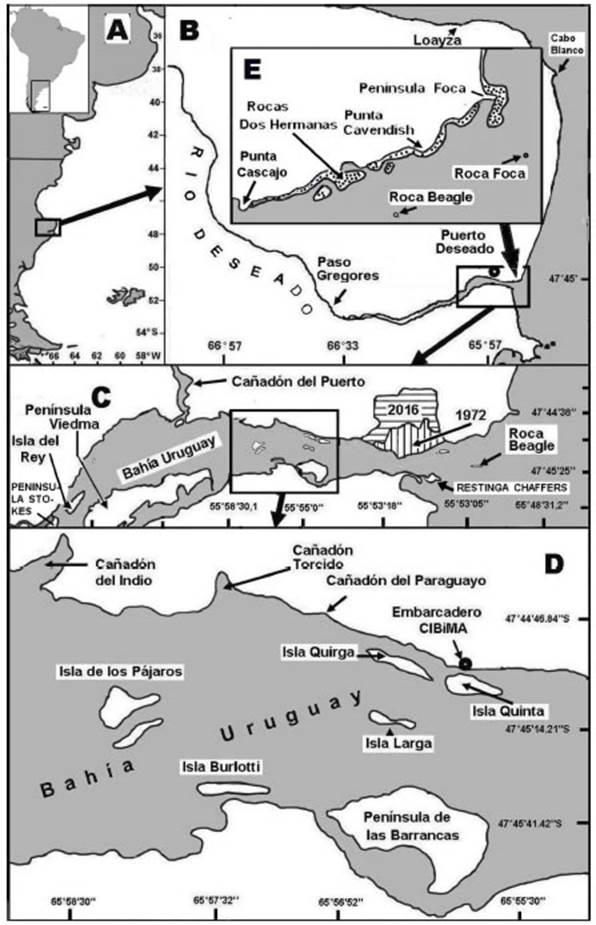
Fig. 1 Ría Deseado. A: location in the South American Atlantic coast. B: enlarged area of the Ria Deseado. C: general sectorization of the Ría Deseado. D: detail of the Bahia Uruguay sector. E: detail of the northern sector of the mouth of the Ría Deseado.
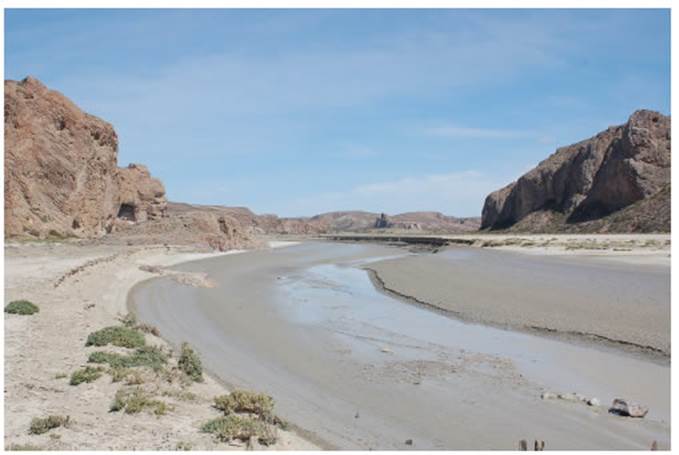
Fig. 2 View of the Deseado Estuary, 42 kms from the mouth, site known as Paso Marsicano, where Mister Chaffers led Charles Darwin.
According to Balech (1954) this region be longs to the Patagonian District of the Magellanic Zoogeographic Province and is influenced almost year around by the cold Malvinas Current. The northern limit between this Province and the Argentine Province (Bonaerensean District), re mains a subject of dispute, though generally it is accepted as occurring approximately between 42-44° S (López, 1963, 1964; Balech, 1965; Boltovskoy, 1981), with fluctuations responding to seasonal changes.
METHODS
The samples were either taken with a 9 m long beach seine (Fig. 4), with hook and line, or by hand in the intertidal zone or beyond. The specimens were fixed in 10% formalin and pre served in 75% ethanol at the Museo Argentino de Ciencias Naturales “Bernardino Rivadavia” Colección Nacional de Ictiología (MACN-Ict), at the Colección de Ictiología of the Centro Nacional Patagónico, Puerto Madryn (CCT CENPAT CONICET, under the catalogue acronym “CNPICT”), and the Colección de Ictiología of the Centro de Investigaciones de Puerto Deseado (CIPD). The systematic ordering follows that of Nelson et al. (2016).
RESULTS
Forty-four species (one hagfish, one chimae ra, eight elasmobranchs, and thirty teleost fish), belonging to 25 families, were found at the Ría Deseado. Below is the complete list of specimens observed or collected.
Class Myxini
Order Myxiniformes
Family Myxinidae
Myxine
Myxine cf. M. australisJenyns, 1842
Class Holocephali
Order Chimaeriformes
Family Callorhynchidae
Callorinchus
C. callorynchus (Linnaeus, 1758)
Class Elasmobranchii
Order Hexanchiformes
Family Hexanchidae
Notorynchus
N. cepedianus (Péron, 1807)
Order Squaliformes
Family Squalidae
Squalus
S. acanthiasLinnaeus, 1758
Order Carcharhiniformes
Family Scyliorhinidae
Schroederichthys
S. bivius (Müller & Henle, 1838)
Family Triakidae
Mustelus
M. fasciatusGarman, 1913
M. schmittiSpringer, 1939
Galeorhinus
G. galeus (Linnaeus, 1758)
Order Rajiformes
Family Myliobatidae
Myliobatis
M. ridensRuocco et al., 2012
Family Rajidae
Bathyraja
B. griseocauda (Norman, 1937)
Sympterygia
S. bonapartiiMüller and Henle, 1841
Class Osteichthyes
Order Osmeriformes
Family Galaxiidae
Galaxias
G. maculatus (Jenyns, 1842)
Order Clupeiformes
Family Clupeidae
Ramnogaster
R. arcuata (Jenyns, 1842)
Sprattus
S. fuegensis (Jenyns, 1842)
Order Siluriformes
Family Ariidae
Genidens
G. barbus (Lacépède, 1803)
Order Lampriformes
Family Trachypteridae
Trachipterus
T. jacksonensis (Ramsay, 1881)
Order Ophidiformes
Family Ophidiidae
Genypterus
G. blacodes (Forster, 1801)
Order Gadiformes
Family Moriidae
Salilota
S. australis (Günther, 1887)
Family Merluciidae
Merluccius
M. hubbsiMarini,1933
Order Perciformes
Family Zoarcidae
Austrolycus
A. laticinctus (Berg, 1895)
Crossostomus
C. fasciatus (Lönnberg, 1905)
Dadyanos
D. insignis (Steindachner, 1898)
Iluocoetes
I. elongatus (Smitt, 1898)
I. fimbriatusJenyns, 1842
Phucocoetes
P. latitansJenyns, 1842
Family Mugilidae
Mugil
M. lizaGünther, 1880
Family Bovichthyidae
Bovictus
B. argentinusMacDonagh, 1931
Family Eleginopidae
Eleginops
E. maclovinus (Cuvier, 1830)
Family Nototheniidae
Dissostichus
D. eleginoidesSmitt, 1898
Paranotothenia
P. angustataHutton, 1875
P. magellanica (Forster, 1801)
Patagonotothen
P. canina (Smitt, 1897)
P. cornucola (Richardson, 1844)
P. brevicauda (Lönnberg, 1905)
P. squamiceps (Peters, 1876)
P. guentheri (Norman, 1937)
Family Harpagiferidae
Harpagifer
H. bispinis (Forster, 1801)
Family Carangidae
Parona
P. signata (Jenyns, 1842)
Family Stromateidae
Stromateus
S. brasiliensisFowler, 1906
Order Atheriniformes
Family Atherionopsidae
Odontesthes
O. smitti (Lahille, 1929)
O. nigricans (Richardson, 1844)
Family Notocheiridae
Notocheirus
N. hubbsiClark, 1937
Order Scorpaeniformes
Family Sebastidae
Sebastes
S. oculatus Valenciennes, 1833
Material examined and observations
The following abbreviations were used throughout this section: CIPD = Centro de Investigaciones de Puerto Deseado. CNPICT = Ichthyological Collection of the CCT CENPAT CONICET (Centro Nacional Patagónico, Puerto Madryn). MACN-Ict = Ichthyological National Collection of the Museo Argentino de Ciencias Naturales “B. Rivadavia”. MLP = Museo de La Plata ichthyological collection. TL = Total Length. SL = Standard Length. AEG = Atila Esteban Gosztonyi. AP = Alejandro Pettovello. GCH = Gustavo Chiaramonte. LLT = Leandro Luis Tamini. MT = Marian Tanuz. LAC = Laura Asseo de Coch. PM = Pedro Medina (Fig. 5). IZ = Ignacio Zizich (Fig. 5). Coll. = collector/s. Obs = observer/s. H/L = captured by hook and line.
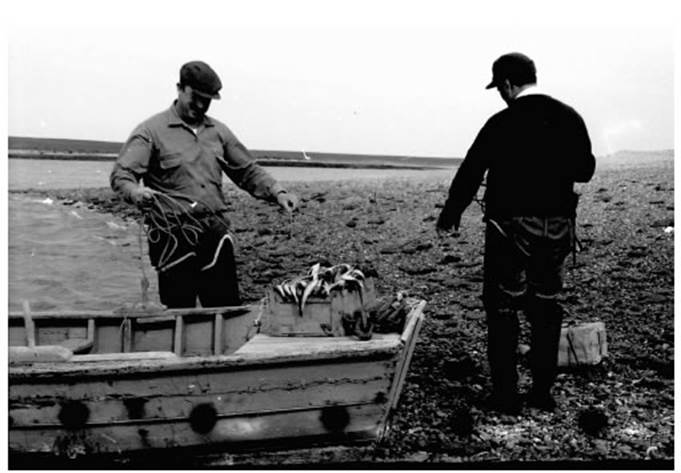
Fig. 5 Preparing the shore seines in Puerto Deseado in 1972. A homage to Messrs. Ignacio Zizich and Pedro Medin.
1. Myxine australis
MACN-Ict 8148, one specimen, Ría Deseado, July 21, 1998, coll. AP.
2. Bathyraja griseocauda
CNPICT 1972, one specimen, Isla Quinta, ca. 800 mm TL, captured H/L, April 9, 1972. Not preserved, but a sketch of the outline of the spec imen traced on paper is preserved. Obs. AEG, coll. Mr. Arabales.
3. Galeorhinus galeus
Rare. One specimen. Not preserved. Obs. AEG, February 1971. See the southernmost record in the area, Bahía San Julián, in Chiaramonte et al. (2016).
4. Mustelus fasciatus
Very rare. MACN-Ict 8198, one specimen, Caleta Tiburón, February 15, 1997, coll. MT (Fig. 6).
5. Mustelus schmitti
Common in soft bottoms. MACN-Ict 8147, four specimens, Caleta Tiburón, December, 1996. In Chiaramonte & Pettovello (2000). Obs. AEG, not preserved, coll LLT, LAC, and MT.
6. Myliobatis ridens
Very rare. MACN-Ict 8019, one specimen, Caleta Tiburón, January 1996, coll. AP (Fig. 7).
7. Notorhynchus cepedianus
Abundant in summer, reaching the upper part of the Ría (e.g., at Estancia Piccinini). CNPICT 1972/140, Caleta Zar, January 31, 1972, skin mi cro slide. CNPICT 1980/31, Bahía Concordia, Estancia Piccinini, jaw in ETOH, February 11, 1980. CNPICT 1980/30, Bahía Concordia, Estancia Piccinini, February 17, 1980, dried jaw. MACN-Ict 8172 (seven specimens), Bahia Uruguay, March 12, 1995 and January 1996, heads and axial skeletons, coll. GCH.
8. Schroederichthys bivius
Common in the 1970 decade (Gosztonyi, 1974a). Also documented by foetuses obtained in egg-cases collected along the coasts of the Ría, 39.7-123.0 mm TL. CNPICT 1969/6, CNPICT 1972/2, CNPICT 1972/4 (four specimens), CNPICT 1972/6 (two specimens), CNPICT 1972/7 (seven specimens), CNPICT 1972/8, CNPICT 1972/9 (two specimens), CNPICT 1981/2 (five specimens). Presently, not observed in the area.
9. Sympterygia bonapartii
A young specimen 127 mm TL, obtained with beach seine at Isla Quinta, September 4, 1970. CNPICT 1970/151, kept in aquarium un til September 10, 1970. Cleared, alizarin stained and mounted in transparent polyester plastic, obs. AEG. MACN-Ict 8303, Caleta Tiburón, February 5, 1995, coll. GCH.
10. Callorhinchus callorhynchus
Common in soft bottoms. Two specimens not preserved, obs. AEG. MACN-Ict 8173, Cañadón del Puerto, Ría Deseado, February 1996, coll. GCH.
11. Bovichtus argentinus
CNPICT 1969/104, Cabo Blanco, head, March 15, 1969, coll. AEG (three specimens do nated to the Natural History Museum, London, received by Mr. Alwyne Wheeler under Accession Number: BMNH 1976.5.13.13). MACN-Ict 8141 (ex 16-CIPD-I), “Las Piletas”, Península Foca, November 9, 1996. coll. A. Vila. Distribution: Península Valdés, Chubut to Puerto Deseado, Santa Cruz.
12. Austrolycus laticinctus
Very common. Large adults are captured by hand with hooks in rock crevices during low tide for human consumption. CNPICT 1969/12-13; 1969/17; 1969/24; 1970/14-14; 1971/16; 1972/20-23; 1972/32-36, 178-498 mm TL, Ría Deseado, under rock or in sub tidal crevices. Obs. AEG (Gosztonyi, 1977). Distribution: coastal and shallow water locations along the Atlantic side of southern South America and in Magellan Strait.
13. Crossostomus fasciatus
Very common. CNPICT 1902/1, 1968/12; 1968/13, 1969/102, 1969/27, 1969/28. 1969/29, 1969/40, 1969/41, 1970/103, 1970/110, 1970/111, 1970/112, 1970/115, 1970/123, 1970/19, 1970/20, 1970/32, 1970/33, 1970/34, 1970/93, 1970/94, 1970/98, 1971/20, 1971/21, 1971/43, 1971/44, 1971/59, 1972/117, 1972/37, 1972/38, 1972/39, 1972/40, 1972/54, 1972/55, 1972/56, 1972/57, 1972/58, 1972/76, 1976/3, 2003/47, 2005/9. Obs. AEG. Distribution: shallow waters on the east ern coast of southern South America (Patagonia, Islas Malvinas and Tierra del Fuego) (Gosztonyi, 1977; Anderson & Gosztonyi, 1991).
14. Dadyanos insignis
Very common. CNPICT 1969/21 (four speci mens), Ría Deseado, under stones. February, 1969, 140, 170, 213 and 218 mm TL. CNPICT 1969/22 (one specimen), Isla Quinta, June 2, 1969, 182 mm TL. CNPICT 1969/2 (three speci mens), Isla Quinta, June 11, 1969, 176, 202, and 218 mm TL. Coll. IZ. 02-CIPD-I (one specimen), beach seine, La Mina (47° 46’ 53” S 66° 04’ 56” W). February 13, 1996. Distribution: intertidal zone and shallow waters on the eastern coast of southern South America (Patagonia and Tierra del Fuego) (Gosztonyi, 1977). Recently found at Puerto Rawson, Chubut. Obs. AP & GCH.
15. Eleginops maclovinus
Very common (Fig. 8). See Gosztonyi (1974b). It is a commercially exploited species, captured by local artisanal angler. CNPICT 1968/6-7, Puerto Deseado and Isla Quinta, February to December, 1968, whole fish. CNPICT 1970/117, Isla Quinta, December 27, 1970, dried skull. CNPICT 1970/91 and 1970/99, Isla Larga, February 25, 1970 and May 20, 1970. CNPICT 1970/124 to 148, Puerto Deseado, May to December, 1970, scales and/or otoliths. CNPICT 1971/39 to 46, Isla Larga and Banco Giménez, February to September, 1971, whole fish. CNPICT 1971/68 to 87, Isla Larga, Isla de los Pájaros, Bahía Uruguay, Banco Giménez, Isla Conejos, Península Stokes, May 27 to December 20, 1971, scales or otoliths. CNPICT 1971/188, Isla Larga, January 7, 1971, whole fish. CNPICT 1972/94 and 124 to 129, 134, 135, 144 to 151, Roca Foca, Isla Larga, Banco Giménez, Old Pier, Isla Quinta, January 7 to December, 1972. MACN-Ict 6447, six specimens, Puerto Deseado, November 1, 1972, coll. AEG. MACN-Ict 8243, Península Foca, February 18, 1996. Distribution: In Argentina, from Bahía San Blas, Buenos Aires to Tierra del Fuego. In Chile, from Tierra del Fuego to Valparaíso. Gosztonyi´s doctoral thesis was made upon material collected here (Gosztonyi, 1979b).
16. Galaxias maculatus
Very rare. Cited by Gosztonyi & McDowall (1974): CNPICT1972/41 to 43, CNPICT 1973/3, CNPICT 1973/4. Found again December 2004 by shore seining near Isla Quinta. CNPICT 2004/43, December 10, 2004.
17. Genypterus blacodes
Known in the area. Skulls are found on the beach occasionally. No specimens preserved.
18. Harpagifer bispinis
Extremely rare in the area. CNPICT 1972/2 (one specimen), 31.5 mm TL, obtained with a dredge in Bahía Uruguay, July 20, 1972. Distribution: very common in Islas Malvinas, Tierra del Fuego, and Isla de los Estados. Obs. AEG. Rare. One specimen not preserved. Punta Cavendish, Jun. 22, 1970, obs. AEG. Observed again in 2001 during octopus artisanal fishing near Roca Foca, obs. AEG & AP.
20. Iluocoetes elongatus
The most abundant zoarcid in the area with dozens of specimens observed. CNPICT 1971/9, Puerto Deseado, Isla Quinta, Isla Larga (two adults 139 mm and ca. 50 early juveniles about 32 mm TL), coll. AEG. CNPICT 1972/4448 (ten specimens), Isla Quinta, February 16, March 13, March 17, April 10, and September 9, 1972, 93-180 mm TL, coll. AEG. MACN-Ict 8231 (four spe cimens), Punta Foca, February 17, 1996. MACN-Ict 8234 (one specimen), Isla Dos Hermanas, November 1, 1996, coll. AP. MACN-Ict 8236 (one specimen), Isla Dos Hermanas, February 1, 1996. MACN-Ict 8240 (one specimen), La Mina, February 1, 1996. MACN-Ict 8241 (one speci men), Isla Dos Hermanas, February 1, 1996. MACN-Ict 8239, one specimen, Caleta Tiburón, February 1, 1996, coll. LLT, LAC, & MT. Sixty-two specimens in the intertidal zone, Puerto Deseado, Santa Cruz, and egg masses and larvae were recorded at the same locality (Gosztonyi, 1977). Distribution: coastal and shallow waters of the eastern coast of South America, Tierra del Fuego and Strait of Magellan (=Estrecho de Magallanes).
21. Iluocoetes fimbriatus
CNPICT 1969/7 (two specimens), 74 and 80 mm TL. Rare to inshore waters, only as young specimens. Adults common on the Argentine Continental shelf as bycatch of the Argentine hake Merluccius hubbsi. Obs. AEG.
22. Merluccius hubbsi
Observed not preserved.
23. Mugil liza
MACN-Ict 8200 (two specimens), Bahía Concordia, obs. AP, coll. L. Tafra.
24. Genidens barbus
One specimen, H/L. Ría Deseado, Restinga Chaffers, February 17, 1996, obs. AP, coll. D. Bustos. Not preserved.
25. Notocheirus hubbsi
Very rare. Observed for the first time in Argentine waters by AEG upon 22 unregistered females in Puerto Deseado (Gosztonyi, 1972). Ten of the above specimens were donated to the MACN, received by Dr. Rogelio B. López in Puerto Deseado in 1972 (MACN-Ict 6586. Dec. 12, 1970, Puerto Deseado, coll. AEG). Two additional spec imens: CNPICT 1970/3, Punta Cascajo, 46.4 mm TL, captured by beach seine, coll. IZ. CNPICT 1972/11, Punta Cascajo, May 15, 1972, coll. Jorge Naves, with a bucket when detecting the school from the shore. N. hubbsi was recently found again by AEG January 30, 2006 in Argentine wa ters in tide pools in Monte León National Park, Santa Cruz Province (CNPICT2006/53; Fig. 9). Distribution: near Valparaíso (Chile) and Santa Cruz Province.
26. Odontesthes nigricans
Very often observed and collected by AEG. Common in artisanal shore seining, up to 200 mm TL. CNPICT 1970/9 (four specimens), October 1970. CNPICT 1971/6 (twelve specimens), Ría Deseado, May 25, 1971. CNPICT 1971/7 (more than 20 specimens), Isla Larga, April 20, 1971, coll. AG. CNPICT 1972/17 (three specimens), Ría Deseado, January 28, 1972. MACN-Ict 7480, Puerto Deseado, July 10, 1986, coll. G. Piacentino. Distribution: from Peninsula Valdés to the Beagle Channel and Islas Malvinas.
27. Odontesthes smitti
Very common in shore seining performed by local artisanal fishermen. AEG collected nu merous specimens. CNPICT 1968/9 (two speci mens), Isla Quinta, December 03, 1968. CNPICT 1970/39, 40, 96, 104-196, 194, and 196 (thirty-eight specimens), Isla Quinta or surround ings, May to December 1970, whole or alizarin stained. CNPICT 1971/ 10, 22, 23, 48, and 64 (sixty-nine specimens), January 26 to May 27, 1971, whole fish or stained, 47 to 202 mm TL. CNPICT 1972/49 (twenty-three specimens), Ría Deseado, January 28, 1972, 161 mm TL, coll. M. Marcinkekicius. CNPICT 2004/35 (twenty-three specimens), Isla Quinta, December 10, 2004, coll. C. Ituarte, C. Gilardoni, E. Bagnato, and G. Posadas. CNPICT 2012/3 (three speci mens), in front of the camping, April 10, 2012-04. MACN-Ict 6539, February 1, 1972, coll. AEG. MACN-Ict 9764, Puerto Deseado, March 1980, coll. G. Piacentino. 12-CIPD-I, La Mina, February 2, 1996, caught by beach seine, coll. GCH. Common in artisanal fishery. Distribution: known from Mar del Plata to Tierra del Fuego. This is the most widely distributed atherinopsid in Argentine waters.
28. Paranotohenia magellanica
Common. CNPICT 1962/5 (one specimen), Punta Cavendish, February 8, 1962, coll. AEG. CNPICT 1968/40 (one specimen), Puerto Deseado, December 18, 1968. CNPICT 1970/62 (one speci men), Isla Quinta, July 12, 1970. CNPICT 1972/96 (one specimen), Puerto Deseado, Abril 16, 1972, coll. AEG. CNPICT 1972/97 (one specimen), Puerto Deseado, February 15, 1972. MACN-Ict 8242, Punta Foca, February 1, 1996, coll. AP.
29. Paranotothenia angustata
MACN-Ict 8139 (one specimen), Las Piletas (47° 45’ S - 65° 55’ W), April 14, 1997, coll. C. Temporelli. 03-CIPD-I (one specimen), H/L, Península Foca, February 1996, coll. P. Chinni. 11-CIPD-I (two specimens), Isla Quinta, February 27, 1996, coll. LLT.
30. Parona signata
Two specimens, obs. AEG, January 26-27, 1972. One specimen H/L, Bahía Uruguay, and one caught by shore seining. None preserved.
31. Patagonotothen brevicauda
Uncommon. Three specimens preserved: CNPICT 1969/2; Roca Foca, April 6, 1969. CNPICT 1969/3, March 8, 1969, H/L from pier; CNPICT 1972/1, Bahía Uruguay, H/L.
32. Patagonotothen canina
Not common. CNPICT 1972/53 (one speci men), Puerto Deseado, March 8, 1972, H/L from pier, coll. PM. CNPICT 1970/2 (one specimen), Puerto Deseado, February 21, 1970, tide gauge, coll. AEG. CNPICT 1972/51 (one specimen), Isla del Rey, January 30, 1972, H/L, coll. PM. CNPICT 1971/24 (one specimen), Puerto Deseado, March 1971, H/L from pier, coll. PM. CNPICT 1972/52 (one specimen), Puerto Deseado, April 1972, H/L, coll. PM. CNPICT 1962/3 (two specimens), Bahía Uruguay, January 17, 1962, coll. IZ.
33. Patagonotothen cornucola
Very common in rocky bottom tide pools. CNPICT 1968/35 (four specimens), February 1968, Puerto Deseado, coll. AEG. CNPICT 1968/63 (six specimens), Isla Quinta, December 3, 1968, coll. AEG. CNPICT 1969/98 (one speci men), Isla Quinta, April 8, 1969, coll. AEG. CNPICT 1969/99 (one specimen), Isla Quiroga, July 2, 1969, coll. AEG. CNPICT 1969/101 (two specimens), Isla Quiroga, July 17, 1969, coll. AEG. CNPICT 1969/64 (four specimens), Isla Dos Hermanas, July 7, 1969, coll. AEG. CNPICT 1970/21 to 24. 33, 35, 48, 49, 51, 97, 101, and 121 (twenty specimens), Punta Cavendish, Isla Quinta and Isla Dos Hermanas, September 9 to August 28, 1970, coll. AEG. CNPICT 1971/33 (six specimens), Punta Cavendish, September 16, 1971, coll. AEG. CNPICT 1972/83 to 84, 86 to 88, 101, and 143 (fourteen specimens), Isla Dos Hermanas, Restinga Chaffers, Isla Larga and Banco Giménez, January 23 to July 14, 1972, coll. AEG. 05-CIPD-I (nine specimens), Península Foca, February 17, 1996, manually collected in tide pools under rocks, AP and GCH. MACN-Ict 6311 (three specimens), Isla Dos Hermanas, August 1, 1971, coll. A. Torno. MACN-Ict 8233 (nine specimens), Isla Dos Hermanas, August 16, 1971, coll. A. Torno. MACN-Ict 8235, Punta Foca, February 1, 1996, coll. AP. Distribution: from Península Valdés to Tierra del Fuego.
36. Patagonotothen ramsayi
Not very common. CNPICT 1962/1 (one spec imen), Bahía Uruguay, February 17, 1962, H/L. CNPICT 1970 (one specimen), February 2, 1970, H/L from pier, coll. PM. CNPICT 1970/8 (one specimen), February 21,1970, 169 mm TL, H/L from pier, coll. PM. CNPICT 1971/4 (one speci men), March 1971, 246 mm TL, H/L from pier, coll. PM. CNPICT 1971/5 (one specimen), March 1971, 246 mm TL. CNPICT 1972/15 (one speci men), Isla del Rey, January 30, 1972, 199 mm TL, H/L, coll. PM. CNPICT 1972/19 (one specimen), Bahía Uruguay, February 13, 1972, coll. PM.
37. Patagonotothen sima
The most abundant and common fish in tide pools of the Ría Deseado in rocky bot toms. Collected by AEG or otherwise indicated: CNPICT 1968/1 (one specimen), Ría Deseado, August 1968. CNPICT 1968/2, 21, 22, 34, 42, and 62 (forty-two specimens), February to December, 1968, coll. IZ, PM, and AEG. CNPICT 1969/1, 19, 31, 50 to 55, 59 to 62, 65. 74, 93 to 96 (one hundred and nine specimens), February 19 to September 20, 1969, coll. IZ, PM, and AEG. CNPICT 1970/ 36, 41 to 46, 63, 79 to 89, 107 to 109 (eighty-four specimens), Isla Dos Hermanas, Isla Quinta, Isla Larga and Punta Cavendish, January 20 to December 10, 1970. CNPICT 1971/11, 29, 30, 47 (thirteen specimens), Isla Quiroga and Isla Larga, January to December 1971. CNPICT 1971/35, Puerto Deseado, coll. Bulla and Ronderos. CNPICT 1972/75, 78-81, 138, Isla Dos Hermanas, bajío Isla Quinta and Isla Larga. CNPICT 1972/78 (three specimens), Isla Dos Hermanas, July 14, 1972. MACN-Ict 6307 (five specimens), Punta Cavendish, August 15, 1971, coll. A. Torno. MACN-Ict 6308 (twelve specimens), Isla Dos Hermanas, August 1, 1971, coll. A. Torno. MACN-Ict 6309 (three specimens), Punta Roca, August 1, 1971, coll. A. Torno. Cited by Gosztonyi and López Arbarello (2000), de scribing the sexual dimorphism in the dorsal fins, which are much larger in males than in females.
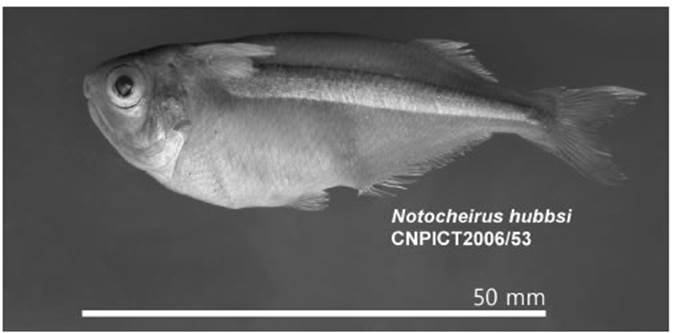
Fig. 9 Notocheirus specimen stored at the CNPICT Collection, captured in Monte León, Santa Cruz in 2006.
38. Patagonotothen squamiceps
Common in the area in sub tidal waters, e.g., in giant kelp (Macrocystis pyrifera) rhizoids. CNPICT 1970/1 (three specimens), Isla Quinta, July 6, 1970. CNPICT 1970/10-12 (three speci mens), 68-109 mm TL. CNPICT 1971/12 15 (six specimens), Ría Deseado, 53 mm (STL) - 136 mm (TL). CNPICT 1972/3 (one specimen), Banco Giménez (near Isla Quinta), May 2, 1972, collect ed by beach seining. Distribution: from Puerto Deseado to Ushuaia, Tierra del Fuego, where it is very common in sub tidal waters (personal ob servations by AEG).
39. Phucocoetes latitans
Very common under stones in the intertidal zone and in the sub tidal giant kelp rhizoids. CNPICT 1968/3-5, 1971/8, 1972/24-31 (fifty-two specimens), 32-145 mm TL. MACN-Ict 6683 (two specimens), July 17, 1971, Isla Dos Hermanas, coll. A. Torno. 08-CIPD-I (three specimens), beach seine, La Mina, Ría Deseado, February 13, 1996, coll. AP and GCH. Distribution: intertidal zone and shallow waters on the continental shelf of Patagonia, Islas Malvinas and Tierra del Fuego (Gosztonyi, 1977; Lloris & Rucabado, 1991).
38. Ramnogaster arcuata
Common during the summer. CNPICT 1962/2 (four specimens), Ría Deseado, November 11, 1962, 62-107 mm TL, coll. IZ. CNPICT 1965/1 (seven specimens), Ría Deseado, 63-106mm TL, coll. IZ. CNPICT 1972/93 (twenty-two specimens), near Isla Quinta, January 28, 1972, 67-81.6 mm TL, coll. IZ and AEG. Twenty-two specimens col lected by IZ at Bahía Uruguay, November 1972, seventeen of which were donated to the Natural History Museum, London in 1974, received by Dr. Peter Whitehead, and are under accession numbers BMNH 1974.9.6-21. 04-CIPD-I (forty specimens), Isla del Rey, February 2, 1996, beach seine, coll. O. Juanola and GCH. 06-CIPD-I, Isla del Rey, January 23, 1996, coll. AP and O. Juanola. 09-CIPD-I, La Mina, February 2, 1996, coll. GCH and O. Juanola. MACN-Ict 8244 (six specimens), February 1, 1996, La Mina, coll. GCH.
39. Salilota australis
Observed occasionally by AEG. Usually cap tured with H/L. No specimens preserved.
40. Sebastes oculatus
Uncommon. CNPICT 1970/4 (one specimen), February 24, 1970, collected with H/L from pier, 166 mm SL. CNPICT 1972/12 (one specimen), Cañadón del Paraguayo, March 10, 1972, 215 mm TL, (cited by Venerus et al., 2003). CNPICT 1972/13 (one specimen), Ría Deseado, April 22, 1972, 136 mm. CNPICT 1972/14 (two specimens), Ría Deseado, April 22, 1972, 235-235 mm TL.
41. Sprattus fuegensis
Very common during spring and summer in shore seining operations. CNPICT 1970/18 (three specimens), Ría Deseado, December 10, 1970, ca. 50 mm TL, coll. IZ. CNPICT 1971/17 to 19 (forty-one specimens), Ría Deseado, January 18, 1971 and September 29, 1971, 50-117mm TL. Thirty-two specimens were donated to and deposited at the Natural History Museum, London, under ac cession numbers BMNH 1974.9.21.1-5, BMNH 1974.9.21.6-21 and BMNH, 1974.9.21.22-33, received by Dr. Peter Whiteheaed. 01-CIPD-I (twelve specimens), Ría Deseado, February 15, 1995, beach seine, coll. L. Tafra. MACN-Ict 8232 (three specimens), November 2, 1997, Muelle Ramón. MACN-Ict 8245 (seven specimens), November 4, 1998, Muelle Ramón. Distribution: Northern Patagonia to the Beagle Channel.
42. Stromateus brasiliensis
Observed by AEG during shore seining oper ations. No specimens preserved. 10-CIPD-I (two specimens), La Mina, February 2, 1996, beach seine, coll. AP.
43. Trachipterus jacksonensis
Very rare. Cited upon a single specimen 1200+ mm TL, stranded in the Ría Deseado prior to 1970, preserved at La Plata Museum (MLP 1.12.1977.1).
44. Dissostichus eleginoides
MACN-Ict 8884 (two specimens), Puerto Deseado, coll. AP.
DISCUSSION
There are two Zoogeographic provinces in the western South Atlantic: The Argentine Province in the North and the Magellanic Province in the South, with the boundary among them at about 42°S. The definition of the provinces is enhanced by the cold temperate (Subantarctic) character of the former, and the warm temper ate (subtropical) character of the latter (Menni & Stehmann, 2000). For fishes, Menni & Gosztonyi (1982) and Menni & López (1984) stated that the classical division of the Magellanic Province into a Bonaerensean Distric and a Magellanic District is extremely consistent and zoogeographically convenient, as noted by many authors (Balech, 1964; López, 1963, 1964; Krefft, 1968). Moreover, with the corresponding fish faunas, further as sociations of lower biological level (Fager, 1957; Margalef, 1984) were identified (Boschi et al., 1981; Menni & Gosztonyi, 1982; Ishino et al., 1983; Menni & López, 1984; Diaz de Astarloa et al., 1999).
In the Magellanic District, the Patagonian continental shelf, south of 47-48º S, is mostly covered by Subantarctic waters (Balech, 1986), but in summer the coastal zone, between the continent and the Malvinas current, receives a warm water mass from the north, and its influ ence is clear throughout the aforesaid latitudes (López, 1963). This coastal water mass has been recognized by several authors (Hart, 1946; Balech, 1965, 1986; Brandhorst & Castello, 1971; Boltovskoy, 1981) and constitutes the western branch of the Brazilian current. In addition, there is a thermal difference of approximately 7 °C between the two streams that develop a mix ing zone on this front, resulting in a winding or meandering front with small patches or “islets” of one water current, which are isolated between waters of the other current (Bellisio et al., 1979). Thus, the presence of subtropical species on the Patagonian coasts during the summer would not be strange, as López (1963) has noted: e.g., Pomatomus saltatrix in the Golfo Nuevo (43° S, approximately), Xiphias gladius in Comodoro Rivadavia (46° S), Parona signata in Río Gallegos (52° S).
The biogeographic origin of the collected spe cies in the Ría Deseado shows that its ichthyiofau na is composed mainly of typical Magellanic fish es (most noticeably, the Zoarcidae, Eleginopidae, and Nototheniidae), while some Bonaerensean forms are also present. It is possible that the summer transgressive influence of the western branch of the Brazilian current, together with the particular oceanographic characteristics of the Ría (sheltered and highly productive), have provided the necessary conditions for the occur rence of typical Bonaerensean fishes. However, it should be pointed out that biogeographical analyses show that they do not addressed local aspects, such as the mixing phenomena of dif ferent types of fauna, e,g., the co-occurrence of strictly coastal and pelagic ichthyofaunas (Lloris & Rucabado, 1991). In this regard, some cases deserve further discussion.
Although the specimens of Mustelus fascia tus and Myliobatis ridens apparently constitute accidental occurrences in the area, they seem to indicate that the northern zoogeographic in fluence is probably being underestimated, and that this coastal area has a transitional nature, forming a true ecotone between the Magellanic and Argentine provinces. López Cazorla & Menni (1983) remark that M. fasciatus -a typi cal Argentine Province shark- has never been caught further south than 39° 30’ S, despite con siderable sampling (Otaki et al., 1971; Menni & Gosztonyi, 1982; Menni & López, 1984); never theless, in non-scientific records, such as those of fisheries reports, some specimens of this spe cies could have been mistakenly interpreted as M. schmitti due to their morphological similari ties. More recently, and based in a shark tagging citizen science project Cuevas et al. (2018) have extended the latitudinal range to 40° 52ʹ S. The southern eagle ray, Myliobatis goodei, has been considered a typical fish from Buenos Aires (Menni & Gosztonyi, 1982; Menni & López, 1984; Menni & Stehmann, 2000), and is even consid ered a biological indicator of the Brazilian cur rent (Castello, 1974). The recent recognition of the new cryptic species M. ridens may serve as a new point to explain the occurrence of Myliobatis species in this area (Gosztonyi, 1981; this work), since the wide ranges of depth and salinity tol erance attributed to M. goodei by Cousseau & Perrotta (1998) could be masking those of M. ridens, a species that could have a greater range of thermal tolerance.
In a publication that widens the latitudi nal distribution range of the Triakid shark Galeorhinus galeus by two degrees to the south and discusses the potential impact of climate change in the southward extension of the distri bution of the species, Chiaramonte et al. (2016) pointed out that “although the geographical references in the South West Atlantic almost always came from commercial fisheries data, in recent years monitoring the effort on coastal and embarked recreational fishing has increased (Cedrola et al., 2011). This could represent an amendment of the biases in historical records, and not a widening of its distribution”. Thus, the increase of monitoring efforts on coastal en vironments could explain these new findings of Bonaeresean fauna at higher latitudes.
Besides the mentioned studies, which mostly are zoogeographical analyses, there is a notewor thy finding that would need further analysis. Comparing the species observed in the 1970´s and taking into account the most common spe cies, it can be seen that most of them seem to be in the area in subsequent years. But there is a notable exception: the scyliorhinid shark Schroederichthys bivius. As stated above, in the 1970s numerous egg-cases of this shark could be found along the shore entangled in seaweeds washed ashore within the Ría. This was partic ularly common in the vicinity of the Isla Larga (Fig. 1D) indicating that the Ría were acting as a nursery area for this catshark. Already at the be ginning of the 21st century, Chiaramonte (2005) warned about the disappearance of the species in the Ría Deseado, and in a survey made in 2009 in the same area by AEG, not a single catshark egg case could be found. New surveys should be performed to corroborate the disappearance of this shark. Should this be the case, attention ought to be given to the probable causes, and two alternatives could be hypothesized for it: a) the population of the shark has drastically de creased due to overfishing in the open sea; or b) the habitat or the quality of the Ría´s waters has changed to a dangerous quality for this species as Chiaramonte (2005) previously was warned.












 uBio
uBio 
